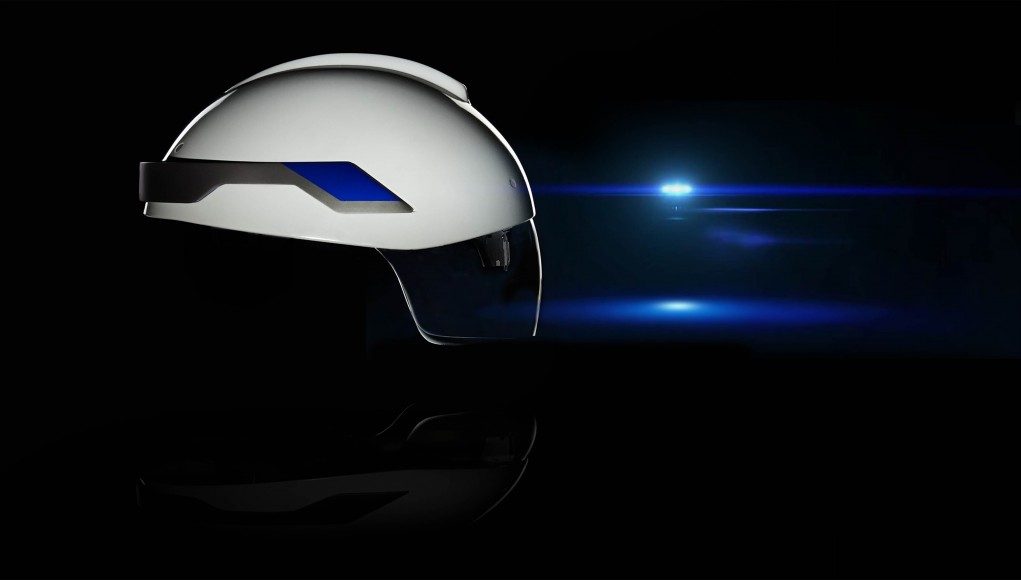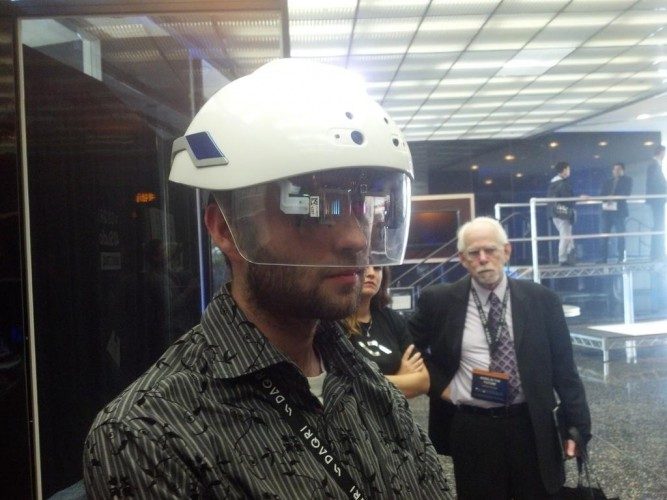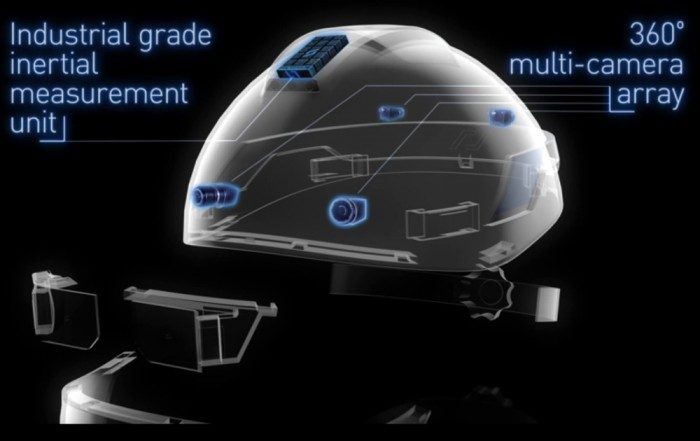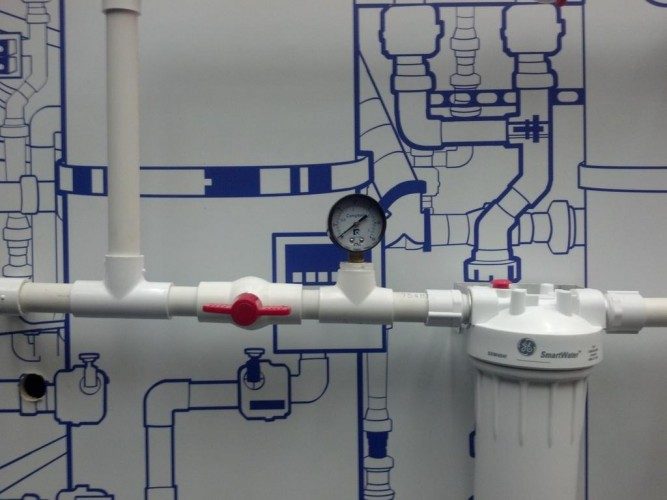The DAQRI Smart Helmet is a prototype in the works by a Los Angeles-based company who is approaching augmented reality from an industrial standpoint rather than a commercial one. It features thermal imaging, head tracking, motion sensing, pattern recognition, and much more.
I tried out this unique AR headset at the 4D Expo hosted by DAQRI in downtown LA that lasted two days. The relatively small conference included presentations from various industry leaders along with panel discussions and even a fireside chat with LA’s CIO, Peter Marx. Among the demonstrations, the DAQRI’s AR Smart Helmet was by far one of the most exciting technologies that the company had to offer.
As DAQRI’s press brochure states, the AR Smart Helmet is looking to set “a new standard for industrial, professional-grade wearables.” The document goes on to describe how “a world class sensor package has been fused with an intuitive user experience, driven by native augmented reality software and DAQRI’s Intellitrack system for the most precise display and tracking possible, and providing users with unprecedented levels of information about the world around them.” The product page for Intellitrack goes on to say that:
DAQRI’s Intellitrack software represents the latest advancements in computer vision. Utilizing visual inertial navigation in conjunction with the most sophisticated sensor package ever created for augmented reality, Intellitrack uses the data from DAQRI Smart Helmet’s 360° navigation cameras and industrial-grade inertial measurement unit to create a complex mathematical model that understands how to avoid potential errors in tracking. This allows it the unique flexibility to avoid spatial placement errors and maintain contextual tracking anywhere.”
When I initially put on the helmet, the first thing I noticed was how light the device was. The original prototype they showed me weighed 1-2 pounds or so and fit comfortably on my head. This is surprising because DAQRI packed a lot of high-tech sensors and hardware into the headset. It felt like a regular construction hardhat except this did far more than protect my head. Although it was lighter than I expected, the exhibitors informed me that the newer prototypes they are working on reduce the weight yet further.
The outside of the slick white headset contains four cameras (two in front and two in back) which combine to form a 360-degree array. It includes a high definition depth sensor embedded into the frame and even has a flashlight on the top as well. These cameras allow the helmet to continuously record the wearer’s surroundings, documenting the environment wherever the person goes. The goal is to have a real-time video capture system that can be accessed by any supervisor so that they can view exactly what the other on-site worker is seeing.
DAQRI’s Smart Helmet promotional video shows the company’s vision for the headset:
Inside the headset, there are two lenses clamped together at the ends leading to light sources that project images onto the glass from the sides. The first experience DAQRI showed me was thermal imaging (or infrared) vision. When I looked out from within the headset, a display similar to a small television screen hovered just beyond the protective surface of the helmet. It showed colorful overlays of the objects in view based on their temperature ranges. It was reminiscent of the Predator movies where creatures in the films could ‘see’ heat in a similar fashion.
In terms of field of view (FOV), one of the DAQRI employees mentioned to me during the demonstration that the original AR prototype’s field-of-view is approximately 80 degrees. However, the newer version is hoping to reach 120 degrees before its official release.
Obviously, being that this is an augmented reality setup and not a virtual reality one, there was no screen involved. The lenses seemed to make use of a waveguide to send light from the sides of the lenses to the middle, and then into the eye, yet it was hard to tell exactly how it worked just by looking at it. The headtracking latency was fairly low, which was nice to see on such an early prototype.
I was able to detect a little bit of jitter on the thermal imaging overlay, but it was subtle. The heads-up display on the augmented reality portion seen later was not noticeably 3D though. Still, the main concepts are strong and with additional work, it is easy to see the imaging of the Smart Helmet getting a whole lot better relatively quickly as a release date approaches.
After putting on the Smart Helmet for the first time, DAQRI employees led me to various demo locations to demonstrate the thermal imaging feature. One of the spots they brought me too had a hot glue gun lying on a table. With the thermal imaging capabilities of the helmet, it was easy to see which parts of the tool were hot. It was clear that the extruder would be too hot to touch. Later I walked over to three electrical panels protruding out of a wall and was asked to detect which panel had electricity running through it. This specific demonstration could be exceptionally useful for electricians who are looking to find overheating faults in mechanical components. After that, the exhibitor led me to a series of motors and again questioned me about which ones were running.
In another demonstration, I was shown was a gauge detecting system. This works by taking a snapshot of the object which is then evaluated to see if there is a circle within the image. If detected, a simple geometric algorithm will be initiated to gather the needle’s angle. From there, the system can work out the reading.
The final demonstrations had to do with pattern recognition and computer vision. Standing in front of complex printed graphics placed on the walls, tables, and floors, prompted the headset to fire up visual image processes depending on where I was looking.
For example, one of the graphics showed the temperature of the room. Another pattern that was printed out was placed on a nearby wall that initiated a training sequence once the Smart Helmet detected that specific graphic. It was essentially a tutorial on how to use the headset. ‘Menu’ options hovered in front of my field of view that allowed for the training to continue depending on what objects I looked at.
Using pattern recognition like this is somewhat limited because augmented reality headsets similar to the Smart Helmet have to search for customized graphics from a local database in order to recognize what’s being looked at. Currently, there is no standard for the augmented reality markers as a whole. Instead, companies like DAQRI have to create create custom graphics that only their systems are tuned to detect.
These types of AR devices are merely prototypes in the works, granted, it’s unlikely that visual cues similar to what was seen at DAQRI’s offices will be found in real-world work environments any time soon; unless someone goes around and places stickers on the surfaces of all the objects in the area. However, large-scale commercial operations could potentially deploy AR-ready ‘barcodes’ on their inventory and equipment, which would help devices like DAQRI’s Smart Helmet detect exactly what the object is.
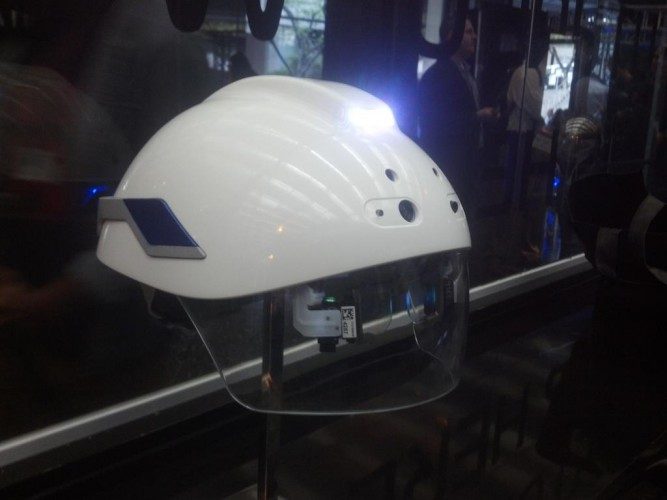
The experiences shown in the public area were impressive, but even more interesting devices were being tested out on the 9th floor of the building, where DAQRI’s offices and research facility are located. DAQRI was mostly only showing those upper-level projects to industry clients at the 4D Expo, so not everyone at the conference had the opportunity to see exactly what they were working on. Luckily, I was able to network my way through and get a glimpse into the future of industrial augmented reality.
The first thing that caught my attention was a machine that looked like a robot arm. It reminded me of a device that would typically be found in an auto manufacturer’s facility. It had a DAQRI’s Smart Helmet placed on top of it and was moving the headset around in many directions in order to test the internal Inertial Measurement Unit (IMU).
On a table in a far corner of one of the rooms was a handful of circuits strewn about. These hardware units were the ones integrated into the original prototype of the Smart Helmet. Next to them was one small circuit that was about the size of a thumb-drive. This was the newest revision that will be found in updated versions of the headset. It was created through a partnership with Qualcomm, who was able to condense all of the previous boards into one, tiny circuit. It was impressive to see all of the capabilities of the Smart Helmet running off of such a small device. In addition, it was noted that the batteries for the original design last about 2 hours, but the newer version runs closer to 12 hours.
Near those circuits was a glass case holding up the inner workings of a smart headband that was developed by a company called Melon, which DAQRI recently acquired. The acquisition was announced during the 4D Expo on the first day, which was reported first by the LA Times.
The extremely light wearable contains Electroencephalography (EEG) sensors that detect electrical signals from the brain. The headband can analyze stress levels to determine how focused the wearer is. This allows the headset to detect if a person is tired and can initiate a notification letting them know that they should probably take a break if needed. This feature puts the safety of the workers as a top priority which is a critical concern when working in areas of construction where injuries caused by mistakes can happen easily. Although the technology by Melon is not included in the original Smart Helmet prototype, DAQRI is looking to integrate it in future versions.
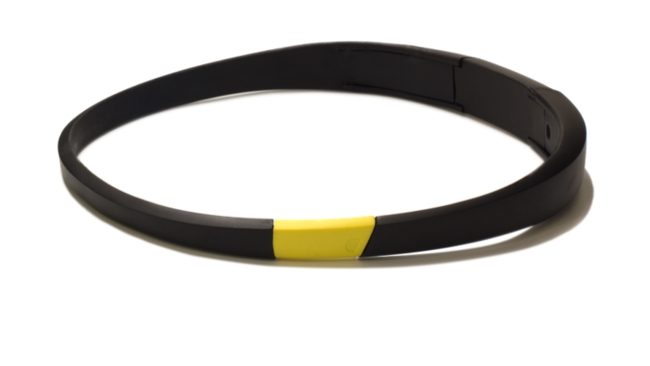
Everything that that was shown at the DAQRI offices was exciting to see, however there were two items that stood out to me the most. There were two newer, unannounced versions of the Smart Helmet that were displayed behind glass cases in one of the rooms. Unfortunately, I wasn’t able to take any pictures of the headsets (or try them out) despite my efforts to try and persuade the nice man giving me the tour.
The first helmet was labeled as a medical device to be used by people like surgeons, but to me it looked like something a surveyor would wear in a construction setting. It’s essentially a lighter, stripped down version of the initial Smart Helmet prototype that resembled glasses more closely than a hardhat.
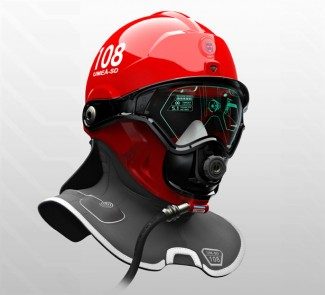
The other prototype, which was my favorite of the two, was designed specifically with firefighters in mind. It had a beautiful red finish with accent marks in yellow and was made to cover the entire head of the wearer. The lenses and light sources are very similar (if not the same) to the original Smart Helmet prototype.
Besides covering the entire head, the main difference between the two was that this custom device had a tube leading out from the bottom of the headset. This turned the helmet it into a self-contained breathing apparatus perfect for firefighters who might find themselves engulfed in smoke.
After trying DAQRI’s smart helmet prototype, it’s clear to me that innovations in augmented reality are going to be led by industrial applications at first. Large companies that are approaching AR in this way tend have the money required to deploy extraordinary devices like this. Granted, the items made by industrial firms like DAQRI are most likely going to produce expensive devices which will not be available for the general public, but they are helping to lay the foundation of AR like never before by proving the concepts first.
There is no official word on what the DAQRI Smart Helmet will cost, but we can almost guarantee that it won’t be cheap compared to a consumer-facing product. We do know however that DAQRI is planning on a Smart Helmet release around December, 2015. It’s amazing to see that augmented reality technology like this currently exists in a working state and is almost ready to be deployed for industrial use. Hopefully, we’ll get more details from DAQRI soon. In the meantime though, be sure to check out their website linked above and watch the video to see more of what DAQRI is up to.

